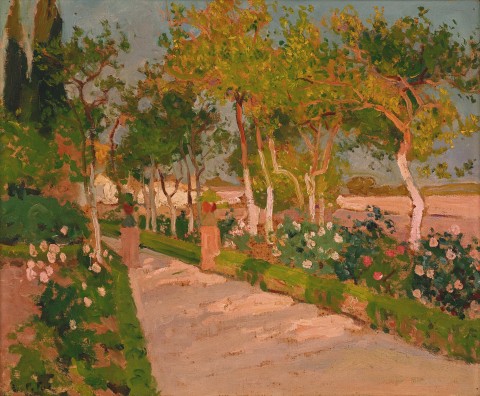A SPANISH GARDEN, c.1911
EMANUEL PHILLIPS FOX
oil on canvas
38.0 x 46.0 cm
signed lower left: E.P. Fox
bears inscription on old label verso: [indistinct] Sp… garden / E Phillips Fox
bears inscription on old label verso: A Spanish Garden / 95 / E/ P…
bears inscription on frame verso: E. PHILIPS-FOX [sic] / “GROVE OF TREES”
Private collection
Christie’s, Melbourne, 11 March 1977, lot 49 (as ‘The Garden Path’)
Thirty Victoria Street, Sydney (label attached verso, dated as c.1906 – 07)
Private collection
Catalogue of pictures by the Late E. Phillips Fox, Fine Art Society’s Gallery, Melbourne, 7 – 11 May 1925, cat. 95
Exhibition of Paintings by the Late E. Phillips Fox and Ethel Carrick Fox, Athenaeum Art Gallery, Melbourne, 27 February – 10 March 1934, cat. 31 (as ‘A Garden in Spain’)
On loan to Newcastle City Art Gallery, New South Wales, 1979
Zubans, R., E. Phillips Fox: His Life and Art, The Miegunyah Press, Melbourne, 1995, cat. 246, p. 223
Painted in Spain, the subject of Emanuel Phillips Fox’s A Spanish Garden, c.1911 is light, not location. The latter provided the occasion. As Fox wrote from Paris to fellow Australian artist Hans Heysen, ‘Early this year middle of Feb … we went off for a round trip determined to get some settled sunlight ’, adding ‘We had a most enjoyable trip staying 3 or 4 days at each place after leaving Bou Saada and working everywhere’.1
Following their London wedding in 1905, Fox and Ethel Carrick settled in Paris near the Luxembourg Gardens. The titles of their paintings tell of their travels. The spring of 1907 was celebrated in Venice, their poetic memories now treasured in major Australian public and private collections. On to Picardy, Morocco, Algiers, Bou Saada, Tangier, and back through Cadiz, Cordova and other sun-drenched sites that Spain had to offer. All are recorded in sparkling colour and deft strokes of the brush, their subject being light. As the shimmering light of Venice entered Fox’s palette in 1907, so did the startling clarity of North Africa influence his art. As the noted Fox scholar Ruth Zubans observed, ‘For Fox the trip served as an artistically broadening experience and an extension of his experiments with light effects’. She continued, ‘The North Africa series, with its high-keyed record of the African sun and the fresh, exceptionally rich paint surfaces is quite distinct in Fox’s oeuvre’.2 Also in Spain, in Bridge at Cordova, 1911 (private collection) the light is of such intensity that the monumental stone bridge and grand buildings seem almost to melt into the heat haze. Fox wrote, ‘We both did lots of work & I think got some good ones about 18 x 14 size – painted at one go’.3 While Bridge at Cordova and A Spanish Garden are of that same favoured size, their sunlit atmosphere is distinctly different. The burning heat of one gives way to the gentle enchantment of the other, pervaded by an almost breathless stillness in its moment of quiet beauty. As sunlight uninterrupted shines from clear blue skies, shadows cast themselves across the pathway and flowers add decorative touches of colour. Its stillness invites the same in the viewer. Embracing feeling, Fox is interested in more than just appearances.
The use of strong diagonals, for the garden path, is one of Fox’s classic compositional devices. It gives the painting a contained dynamism recalled from earlier Italian subjects with tranquil settings, especially Monastery, San Lazzaro (1907), (Sotheby’s Australia, 16 August 2017, lot 17). And as places changed, so occasionally did the signatures. In North Africa, returning through Spain, the earlier ‘E. Phillips Fox’ was sometimes replaced by ‘E. P. Fox’, as in our painting.
Fox’s art is grounded in nature and styled in the French Impressionist methods of plein-air painting. When interviewed in Melbourne before his 1913 exhibition at the Athenaeum, he said, ‘In art everything must start from the springboard of nature. One may treat nature realistically, decoratively, or as a basis for the expression of ideas, but nature must be there.’ 4 Freely painted only a few years before, a little of each is found in A Spanish Garden.
1. Letter to Hans Heysen, 13 September 1911, Hans Heysen Papers, National Library of Australia, MS 5073/1/319A. Quoted in Zubans, R., E. Phillips Fox: His Life and Art, Miegunyah Press, Melbourne, 1995, pp. 181 – 2
2. Zubans, op. cit., pp. 160, 162
3. Fox letter to Heysen, op. cit., p. 182
4. ‘Mr. E. Phillips Fox’, Argus, Melbourne, 21 May 1913, p. 5
DAVID THOMAS
